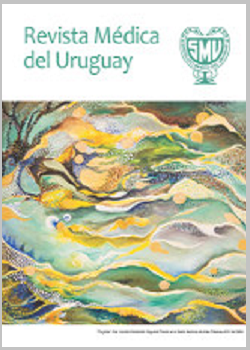Calidad oncológica en cirugía del cáncer de recto
Resumen
Introducción:
el pronóstico del cáncer de recto depende, entre otros factores, de la calidad oncológica de la resección quirúrgica, entre los que se deben incluir la correcta disección del mesorrecto y un adecuado número de ganglios linfáticos.
Objetivos:
describir los principales factores que determinan la calidad de la cirugía de resección por cáncer de recto en la Clínica Quirúrgica 2 del Hospital Maciel.
Pacientes y método:
36 pacientes operados de coordinación en el período 2012 a 2016.
Resultados:
la disección mesorrectal fue completa en el 60% de los casos, y en más del 50% se obtuvo un número aceptable de ganglios linfáticos.
Discusión:
la calidad oncológica de la cirugía por cáncer de recto depende de mútiples factores, entre los que destacamos el volumen anual de cirugías, la experiencia del equipo, factores del paciente (sexo, índice de masa corporal) y de la enfermedad (topografía baja, estadio, respuesta a la neoadyuvancia).
Conclusiones:
los resultados obtenidos pueden considerarse oncológicamente satisfactorios.
Citas
(1) Athlin L, Bengtsson NO, Stenling R. Local recurrence and survival after radical resection of rectal carcinoma. Acta Chir Scand 1988; 154(3):225-9.
(2) Enker WE, Laffer UT, Block GE. Enhanced survival of patients with colon and rectal cancer is based upon wide anatomic resection. Ann Surg 1979; 190(3):350-60.
(3) Heald RJ. A new approach to rectal cancer. Br J Hosp Med 1979; 22(3):277-81.
(4) Heald RJ, Ryall RD. Recurrence and survival after total mesorectal excision for rectal cancer. Lancet 1986; 1(8496):1479-82.
(5) Galler AS, Petrelli NJ, Shakamuri SP. Rectal cancer surgery: a brief history. Surg Oncol 2011; 20(4):223-30.
(6) College of American Pathologists. Protocol for the examination of patients with primary carcinoma of the colon and rectum. Washington, DC: CAP, 2016.
(7) Lujan J, Valero G, Hernández Q, Sánchez A, Frutos MD, Parrilla P. Randomized clinical trial comparing laparoscopic and open surgery in patients with rectal cancer. Br J Surg 2009; 96(9):982-9.
(8) Kearney DE, Coffey JC. A randomized trial of laparoscopic versus open surgery for rectal cancer. N Engl J Med 2015; 373(2):194.
(9) Lin HH, Lin JK, Lin CC, Lan YT, Wang HS, Yang SH, et al. Circumferential margin plays an independent impact on the outcome of rectal cancer patients receiving curative total mesorectal excision. Am J Surg 2013; 206(5):771-7.
(10) Mezhir JJ, Shia J, Riedel E, Temple LK, Nash GM, Weiser MR, et al. Whole-mount pathologic analysis of rectal cancer following neoadjuvant therapy: implications of margin status on long-term oncologic outcome. Ann Surg 2012; 256(2):274-9.
(11) Leonard D, Penninckx F, Fieuws S, Jouret-Mourin A, Sempoux C, Jehaes C, et al. Factors predicting the quality of total mesorectal excision for rectal cancer. Ann Surg 2010; 252(6):982-8.
(12) Edge S, Byrd DR, Compton CC, Fritz AG, Greene FL, Trotti A, eds. AJCC Cancer Staging Manual. 7 ed. New York: Springer; 2010.
(13) Shin R, Jeong SY, Yoo HY, Park KJ, Heo SC, Kang GH, Kim WH, Park JG. Depth of mesorectal extension has prognostic significance in patients with T3 rectal cancer. Dis Colon Rectum 2012; 55(12):1220-8.
(14) Le Voyer TE, Sigurdson ER, Hanlon AL, Mayer RJ, Macdonald JS, Catalano PJ, et al. Colon cancer survival is associated with increasing number of lymph nodes analyzed: a secondary survey of intergroup trial INT-0089. J Clin Oncol 2003; 21(15):2912-9.
(15) Mathis KL, Green EM, Sargent DJ, Delaney C, Simmang CL, Nelson H. Surgical quality surrogates do not predict colon cancer survival in the setting of technical credentialing: a report from the prospective COST trial. Ann Surg 2013; 257(1):102-7.
(16) Madbouly KM, Abbas KS, Hussein AM. Metastatic lymph node ratio in stage III rectal carcinoma is a valuable prognostic factor even with less than 12 lymph nodes retrieved: a prospective study. Am J Surg 2014; 207(6):824-31.
(17) Canessa CE, Badía F, Fierro S, Fiol V, Háyek G. Anatomic study of the lymph nodes of the mesorectum. Dis Colon Rectum 2001; 44(9):1333-6.
(18) Tayyab M, Sharma A, Macdonald AW, Gunn J, Hartley JE, Monson JR. Prognostic significance of lymph node ratio in patients undergoing abdominoperineal resection of rectum. Langenbecks Arch Surg 2012; 397(7):1053-7.
(19) Nagtegaal ID, Tot T, Jayne DG, McShane P, Nihlberg A, Marshall HC, et al. Lymph nodes, tumor deposits, and TNM: are we getting better? J Clin Oncol 2011; 29(18):2487-92.
(20) Shirouzu K, Isomoto H, Kakegawa T. Distal spread of rectal cancer and optimal distal margin of resection for sphincter-preserving surgery. Cancer 1995; 76(3):388-92.
(21) Goldstein NS, Soman A, Sacksner J. Disparate surgical margin lengths of colorectal resection specimens between in vivo and in vitro measurements: the effects of surgical resection and formalin fixation on organ shrinkage. Am J Clin Pathol 1999; 111(3):349-51.
(22) Birbeck KF, Macklin CP, Tiffin NJ, Parsons W, Dixon MF, Mapstone NP, et al. Rates of circumferential resection margin involvement vary between surgeons and predict outcomes in rectal cancer surgery. Ann Surg 2002; 235(4):449-57.
(23) Ryan R, Gibbons D, Hyland JM, Treanor D, White A, Mulcahy HE, et al. Pathological response following long-course neoadjuvant chemoradiotherapy for locally advanced rectal cancer. Histopathology 2005; 47(2):141-6.
(24) White M, Foulis AK, Smith G, Horgan PG, Roxburgh CS. The role of S100 staining in the pathological assessment of perineural invasion in rectal cancer. Colorectal Dis 2014; 16(1):71-2.
(25) Compton CC. Colorectal carcinoma: diagnostic, prognostic, and molecular features. Mod Pathol 2003; 16(4):376-88.
(26) Smith NJ, Barbachano Y, Norman AR, Swift RI, Abulafi AM, Brown G. Prognostic significance of magnetic resonance imaging-detected extramural vascular invasion in rectal cancer. Br J Surg 2008; 95(2):229-36.
(27) Prall F. Tumour budding in colorectal carcinoma. Histopathology 2007; 50(1):151-62.
(28) Hase K, Shatney C, Johnson D, Trollope M, Vierra M. Prognostic value of tumor "budding" in patients with colorectal cancer. Dis Colon Rectum 1993; 36(7):627-35.













